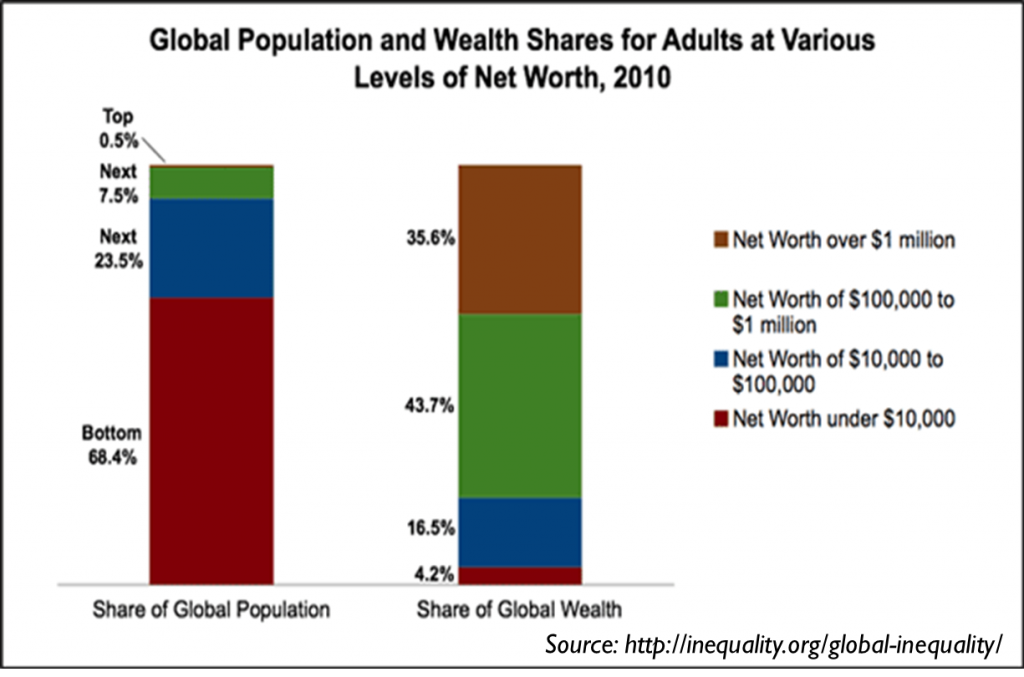 As Dickens put it, “It is the best of times. It is the worst of times.” The world is growing and prospering at unprecedented rates due to rapidly advancing technology, higher levels of education and the near eradication of global boundaries restricting trade. That’s the good news. On the other hand as we experience tsunami like changes in global political, economic and social spheres, the experts agree that there is a widening economic divide between the haves and the have nots.
As Dickens put it, “It is the best of times. It is the worst of times.” The world is growing and prospering at unprecedented rates due to rapidly advancing technology, higher levels of education and the near eradication of global boundaries restricting trade. That’s the good news. On the other hand as we experience tsunami like changes in global political, economic and social spheres, the experts agree that there is a widening economic divide between the haves and the have nots.
 The World Economic Forum has cited the growing global economic inequalities as one of the biggest challenges the world is facing.
The World Economic Forum has cited the growing global economic inequalities as one of the biggest challenges the world is facing.
Consider these statistics:
- The average income of the richest tenth of the Organization for Economic Cooperation and Development (OECD) countries is now about nine times that of the poorest tenth. This gap has increased about 10 percent since the mid-1980s.
- Over the past 30 years in the US, the proportion of national income that the top 1 percent receives has doubled since 1980 from 10 percent to 20 percent and for those in the top .01 percent, there has been a four-fold increase. Another way to understand the difference, between 1979 and 2007, the top 1 percent of households realized a whopping 275 percent increase in median income, while the next 19 percent of the population gained only 65 percent.
- In the UK, in 1985 the top 10 percent of earners made 8 times more than the bottom 10 percent. That gap is now at 12 times.
- In the rising powers of Brazil, Russia, India and China, the ratio is at least 50 to one between the top and the bottom earners. For example in China, the top 10 percent earn 60 percent of all the income.
- South Africa suffers from one of the largest income gaps. Blacks make up 80 percent of the population and their average annual earnings are 1/6 of that of whites. Oxfam research has shown that because it is so unequal, in South Africa, even with sustained economic growth, a million more people will be pushed into poverty by 2020 unless action is taken.

These disparities have had a particularly profound impact on youth between the ages of 15-24, who make up 17 percent of the world’s population. However 87 percent of youth live in developing countries. Consider these facts:
- Youth make up 40 percent of the world’s unemployed.
- The global unemployment rate is about 6 percent compared to the youth rate of 12.6 percent. According to a report just released by the Joint Center for Political and Economic Studies, youth unemployment for African Americans is dire at almost 50 percent.
- 536 million employed youth around the globe are underemployed.
- In some countries, women are even more vulnerable where university educated women are from 3-8 times more likely to be unemployed than their male counterparts.
Economists largely agree that these growing inequities between the rich and the poor do not bode well for the future.
The IMF said that these growing inequalities are dangerous, divisive and could lead to more civil unrest like we saw with youth uprisings around the world last year, including Occupy Wall Street.
Extreme inequality is economically inefficient. There is evidence that some amount of inequality will always exist and can spur the economy by rewarding risk takers who innovate new products and services. However there is widespread agreement by the experts that the current divide is damaging because so much wealth in the hands of a few diminishes overall demand.
Predictions show that if you are born poor in an inequitable country, there is a high likelihood that you will die poor; debunking the myth that everybody can be a millionaire if you just work hard.
Implications and Recommendations for D&I Practitioners:
- There may be more pressure for big companies to limit bonuses and salary increases for top executives which could lead to divisive discourse within the company if not managed well. You should be aware of how salary variances play out in your organization.
- The staggering unemployment and underemployment rates around the world, especially for youth, may point to the need for corporations to take an even more proactive approach to workforce development.
- One of the primary reasons for the unemployment and underemployment predicament is the mismatch between what students learn in schools and the skills that employers need. D&I practitioners should form close relationships with K-12 and higher education to map strategies for closer alignment.
From the perspective of corporate social responsibility, companies should continue to partner with organizations who are dedicated to alleviating the economic divide.

















